Abstract
Background: The use of herbal extracts could represent an advantageous approach for treating sleeping disorders, especially in mild-to-moderate conditions, before the onset of a specific therapy with first-line drugs. Specifically, the focus was posed about the use of extracts from Valeriana officinalis, Ziziphus jujuba, and Humulus lupulus. Multiple studies demonstrated the efficacy of these medicinal plants to positively manage insomnia symptoms. Additionally, their efficacy in the treatment of sleeping disorders could also be improved by their pharmacological association. In the present study, extracts from Valeriana officinalis, Ziziphus jujuba, Humulus lupulus, melatonin, and their pharmacological association, Vagonotte® MEL, were studied for potential application in the treatment of insomnia. Methods: The extracts and melatonin were tested on hypothalamic neurons and tissue for evaluating biocompatibility and protective and neuromodulatory effects. The neuromodulatory effects were evaluated as orexin A gene expression and serotonin steady state level, in the hypothalamus. Results: The extracts and melatonin, although with evident differences, were effective as antioxidant and anti-inflammatory agents; additionally, they were also able to reduce the hypothalamic gene expression of orexin A and the steady state level of serotonin, playing master roles in wakefulness. It is noteworthy that the formulation displayed all the effects of the single ingredients, without any sign of toxicity and pharmacological interference in the hypothalamus. Conclusions: Concluding, the present study explored the biological effects of melatonin and herbal extracts with phytotherapy interest in V. officinalis, Z. jujuba, and H. lupulus. The study demonstrated their intrinsic scavenging/reducing activity, together with protective and neuromodulatory effects in the hypothalamus, with a significant reduction of both orexin A gene expression and serotonin steady state level. Additionally, the study also considered their pharmacological association, which displayed an overall pharmacological spectrum mirroring, including all the effects of the single ingredients, without showing any sign of toxicity in the brain and interference between the extracts and melatonin.
1. Introduction
Insomnia represents the main sleep disorder, and it is related to alteration of the circadian rhythm regulation, finely codified at the hypothalamic level [1]. Recent studies also point to the influence of insomnia in the incidence of neurodegenerative, neuropsychiatric, and metabolic disorders, as well as obesity [2]. This is also related, albeit partially, to the involvement of hypothalamic neuronal populations in different neuroendocrine functions, among which appetite and circadian rhythm, which are influenced in some cases, by the same hypothalamic neuromodulators, such as orexins and serotonin [3,4,5]. Different drugs, among which benzodiazepines, melatonin agonists (i.e., ramelteon), orexinergic, and histaminergic antagonists have been used as first-line medicinals for treating insomnia [6]. Additionally, antidepressant, anticonvulsant, and antipsychotic drugs have also been proposed in the context of off-label uses [6]. Nevertheless, the profile of adverse effects, including alteration in cognitive functions and the development of tolerance, determines a reduction of both patient compliance and therapeutic efficacy [6]; thus suggesting innovative strategies for the managing of insomnia. In this context, the use of herbal extracts could represent an advantageous approach for treating sleeping disorders, especially in mild-to-moderate conditions, before the onset of a specific therapy with first-line drugs [6]. Furthermore, it is also sensitive to the parallelism with another central disorder, namely migraine, which is managed with efficacy with herbal preparations in non-severe forms and in alternative to the use of first-line medications [7,8,9]. Considering the promising phytotherapy approach in the management of insomnia, which is witnessed by the increasing use of herbal preparations throughout the world, in the present studies the effects of herbal extracts from plants with promising applications for treating sleep disorders were investigated at the hypothalamic levels. Specifically, the focus has been on the use of extracts from Valeriana officinalis, Ziziphus jujuba, and Humulus lupulus. Multiple studies have demonstrated the efficacy of these medicinal plants to positively manage insomnia symptoms [10,11]. Additionally, their efficacy in the treatment of sleeping disorders could also be improved by their pharmacological association [12,13]. Indeed, the study considered the evaluation of their efficacy on the levels of hypothalamic orexin-A and serotonin, well-known stimulators of wakefulness [3,14]. Additionally, the study also considered intrinsic antioxidant effects and the evaluation of phenolic compounds present in the extracts. Particularly, the effects were evaluated as regards the single extracts and their pharmacological association with melatonin, an indolic neuromodulator that, besides being a key regulator of sleep/awake rhythm in mammals, is also present in numerous plants of phytotherapy interest, such as Tanacetum parthenium [15]. Finally, a statistical approach, namely principal component analysis (PCA), was performed for discriminating the contribution of each ingredient in the pharmacological spectrum displayed by the proposed formulation.
2. Materials and Methods
2.1. Herbal Extracts
Dry water extracts from roots of Valeriana officinalis L. (0.8% valerenic acid), fruits of Ziziphus jujuba Mill. (2% triterpene saponins), and inflorescences of Humulus lupulus L. (0.4% total flavonoids) were provided by Cristalfarma S.r.l. (Milano, Italy). Melatonin was purchased from Merck (Milano, Italy). Extracts were rehydrated in water via ultrasound-assisted method as previously reported [16]. The extract concentration after rehydration was 80 mg/mL. Extracts and melatonin were also used in combination and the proportions of the extracts and melatonin mirror the composition of the commercial food supplement vagonotte® (Cristalfarma S.r.l.), based only on V. officinalis, H. lupulus, and Z. jujuba at the following ratios 5:2:1, respectively. Whilst, 0.2% melatonin was present in the formulation. The percentage of melatonin in the formulation mirrors its level in herbal extracts [17].
2.2. Colorimetric Assays
Total phenols and flavonoids were determined as equivalents of gallic acid and rutin, respectively, and the detailed protocols are described in our earlier paper [18].
Scavenging/reducing properties were evaluated through cupric ion reduction antioxidant capacity (CUPRAC), ferric ion reduction antioxidant power (FRAP), metal chelating ability (MCA), 1,1-diphenyl-2-picrylhydrazyl (DPPH) and 2,2′-azino-bis(3-ethylbenzothiazoline) 6-sulfonic acid (ABTS), and the phosphomolybdenum (PBD) assay. The details were described in our previous paper [19]. The experimental details were given as supplemental material.
2.3. Eco-Toxicological Assays
The biocompatibility of the ingredients of the formulation were evaluated through allelopathy bioassay and Artemia salina (brine shrimp) lethality assay. Detailed protocols were reported in previous studies of ours [8,9].
2.4. Hypothalamic HypoE22 Cell Culture
Hypothalamic HypoE22 cells were used to evaluate the biocompatibility of the ingredients of the formulation in neurons. In this regard, the viability 3-(4,5-dimethylthiazol-2-yl)-2,5-diphenyltetrazolium bromide (MTT) tests were performed as previously described [20].
2.5. Ex vivo Stimulation of Isolated Hypothalamus
Adult C57/BL6 male mice (3-month-old, weight 20–25 g) were housed in Plexiglas cages (2–4 animals per cage; 55 cm × 33 cm × 19 cm) and maintained under standard laboratory conditions (21 ± 2 °C; 55 ± 5% humidity) on a 14/10 h light/dark cycle, with ad libitum access to water and food. Isolated hypothalamic specimens were maintained in a humidified incubator with 5% CO2 at 37 °C for 4 h (incubation period) in RPMI buffer. During the incubation period, the tissues were challenged with the extracts, melatonin, and their pharmacological association
2.6. Radioimmunoassay Determination of Prostaglandin E2 (PGE2)
Tissue supernatants were collected, and the PGE2 level (ng/mg wet tissue) was measured by radioimmunoassay (RIA). The evaluation of PGE2 was conducted as previously reported [17].
2.7. Determination of Serotonin (5-HT) Level in Hypothalamic Samples
Hypothalamic tissue was homogenized through perchloric acid 50 mM as previously reported. The 5-HT level in the tissue homogenate was analyzed through a high performance liquid chromatography coupled to electrochemical detector (HPLC-EC) apparatus as fully described in our previous study [17].
2.8. Lactate Dehydrogenase (LDH) Determination in Hypothalamic Tissue
LDH activity was measured as previously reported [7].
2.9. Gene Expression Analysis
Total RNA was extracted from hypothalamic specimens using TRI reagent (Sigma-Aldrich, St. Louis, MO, USA), according to the manufacturer’s protocol, and reverse transcribed using a High Capacity cDNA Reverse Transcription Kit (Thermo Fischer Scientific, Waltman, MA, USA). Gene expression of orexin A was determined by quantitative real-time PCR using TaqMan probe-based chemistry, as previously described [21]. PCR primers and TaqMan probes were purchased from Thermo Fisher Scientific Inc. β-actin was used as the housekeeping gene. The elaboration of data was conducted with the Sequence Detection System (SDS) software version 2.3 (ThermoFischer Scientific). Relative quantification of gene expression was performed by the comparative 2−∆∆Ct method [22].
2.10. Statistical Analysis
Statistical analyses were performed using GraphPad Prism version 5.01 software (San Diego, CA, USA). Means ± S.E.M. were determined for each experimental group and analyzed by one-way analysis of variance (ANOVA), followed by Newman–Keuls comparison multiple test. Statistical significance was set at p < 0.05.
Using Pearson correlation analysis, a relationship between biological activity assays and total bioactive components was established. Graph Pad Prism was utilized for the analysis (version 9.2). To provide more insights on tested samples, a PCA was employed. SIMCA was utilized for statistical analysis (version 14.0).
3. Results
3.1. Phytochemical Analysis
The extracts were tested for total phenols and for flavonoid content; V. officinalis and H. lupulus showed similar levels of phenolic compounds, whereas Z. jujuba revealed the lowest content in phenolic compounds (Table 1). Regarding the total flavonoid determination, the highest level was displayed by H. lupulus, whilst V. officinalis showed lower content compared with the other two extracts. Regarding the scavenging/reducing assays, H. lupulus extract displayed a significant activity for each test, whereas melatonin was the most active ingredient of the formulation as an antioxidant (Table 1). The whole formulation mirrors the composition in secondary metabolites and the antioxidant effects (Table 1).

Table 1.
Intrinsic antioxidant properties of V. officinalis, H. lupulus, Z. jujuba, melatonin, and the formulation.
3.2. Eco-Toxicological Assays
In order to define the limits of biocompatibility of the extracts and their pharmacological association, eco-toxicological assays, namely allelopathy and brine shrimp (Artemia salina) assays, were carried out in the concentration range 0.1–40 mg/mL. The allelopathy assay showed null effects on seedling germination of all tested lettuce varieties at concentration <5 mg/mL. Similar results were obtained as regards brine shrimp lethality, which showed LC50 values <5 mg/mL.
3.3. Hypothalamic HypoE22 Cell Cultures
Considering the results of eco-toxicological tests, a concentration at least ten-fold lower compared to the value of LC50 measured in the brine shrimp assay was selected for stimulating hypothalamic cells. V. officinalis, H. lupulus, and Z. jujuba were tested at the concentrations of 500, 200, and 100 µg/mL, respectively. Melatonin was tested at the concentration of 1 µg/mL. The same concentrations were maintained in the pharmacological association group. All treatments did not modify the viability of hypothalamic cells, compared with the untreated control (Ctrl) group; thus, further demonstrating the biocompatibility in eukaryotic cells (Figure 1).
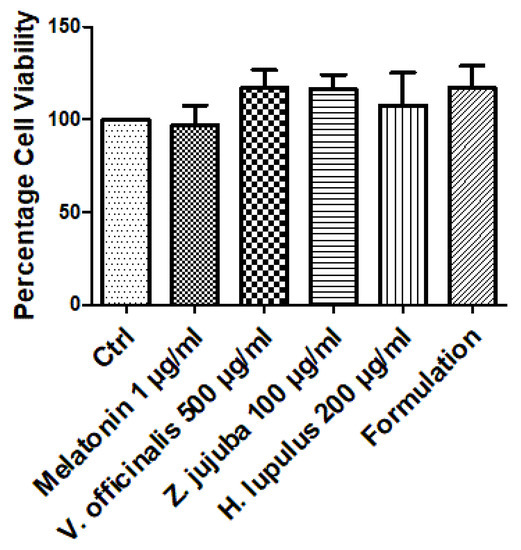
Figure 1.
Null effect induced by V. officinalis, Z. jujuba, H. lupulus, and melatonin on hypothalamic HypoE22 cells.
3.4. Ex Vivo Stimulation of Hypothalamic Specimens Exposed to LPS
In the same concentrations, extracts and melatonin were tested in isolated mouse hypothalamic specimens. Consistent with the abovementioned biocompatibility and antioxidant effects, all treatments were effective in preventing the LPS-induced up-regulation of LDH and PGE2 (Figure 2 and Figure 3), with the formulation being more active in blunting the LPS-induced LDH release, thus indicating a higher efficacy as a protective agent, compared with the single ingredients. Whilst in absence of LPS, all treatments were effective in reducing the gene expression of orexin A and the steady state level of 5-HT in the hypothalamus (Figure 4 and Figure 5). Regarding the orexin A gene expression, H. lupulus extract was the most effective, whereas the highest efficacy in reducing 5-HT hypothalamic level was displayed by Z. jujuba extract.
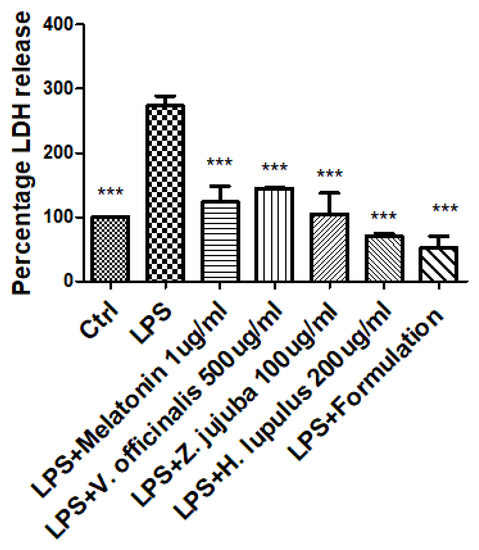
Figure 2.
Inhibitory effects induced by V. officinalis, Z. jujuba, H. lupulus, and melatonin on LPS-induced lactate dehydrogenase (LDH) levels in isolated hypothalamus. ANOVA, p < 0.0001; *** p < 0.001 vs. Ctrl (Control) group.
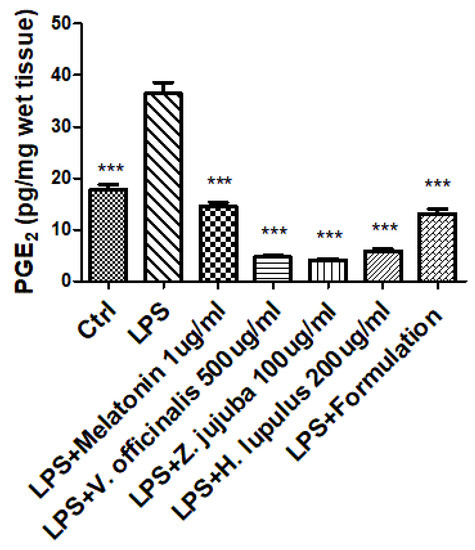
Figure 3.
Inhibitory effects induced by V. officinalis, Z. jujuba, H. lupulus, and melatonin on LPS-induced prostaglandin E2 (PGE2) levels in isolated hypothalamus. ANOVA, p < 0.0001; *** p < 0.001 vs. Ctrl (Control) group.
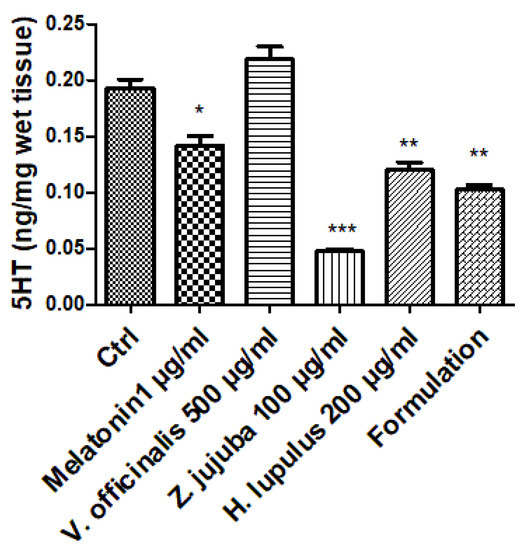
Figure 4.
Inhibitory effects induced by V. officinalis, Z. jujuba, H. lupulus, and melatonin on serotonin (5-HT) levels in isolated hypothalamus. ANOVA, p < 0.0001; * p < 0.05, ** p < 0.01,*** p < 0.001 vs. Ctrl (Control) group.
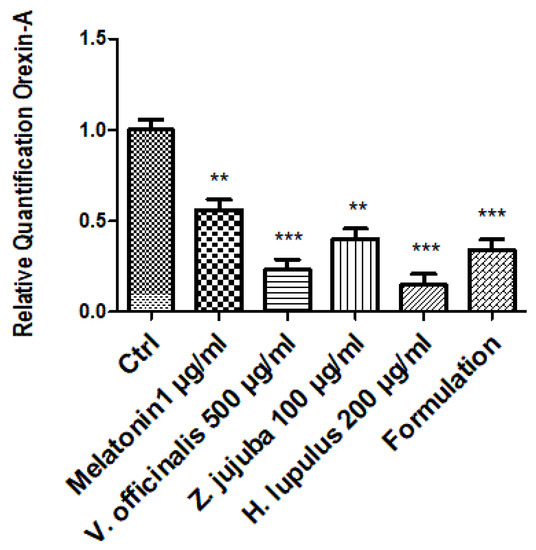
Figure 5.
Inhibitory effects induced by V. officinalis, Z. jujuba, H. lupulus, and melatonin on orexin A gene expression in isolated hypothalamus. ANOVA, p < 0.0001; ** p < 0.01,*** p < 0.001 vs. Ctrl (Control) group.
3.5. Principal Components Analysis (PCA)
To get more information between the samples tested, we performed a principal component analysis based on antioxidant properties and total bioactive compounds. The results are shown in Figure 6. As can be seen in Figure 6a, the analysis consisted of two components (PC1: 55.8% and PC2: 22.7) and they accounted for 78.5% of the total components. The samples tested were clearly distributed in the different axes of the PCA plane. Interestingly, formulation H. lupulus and V. officinalis, were classified very narrowly. From this point on, these components mainly contributed to the antioxidant properties of the formulation. However, the contributions of melatonin and Z. jujuba in the formulation were very small. These findings could indicate that if we want to improve the antioxidant properties of the formulation, V. officinalis and H. lupulus, could be the main players in the actions. The approach was also supported by several researchers who reported significant antioxidant properties in the plants [23,24,25,26,27,28]. In addition to the PCA analysis, Pearson’s correlation between antioxidant methods and total bioactive components was calculated. In general, the bioactive components showed a weak correlation (R < 0.5) with the antioxidant methods. This finding could be explained by the complex nature and interactions (antagonistic or synergistic) of phytochemicals. In further studies, we proposed further isolation and characterization techniques to determine specific correlations between phytochemicals and the observed antioxidant effects. In recent studies, spectrophotometric analysis is not sufficient to determine the level of bioactive compounds [29].
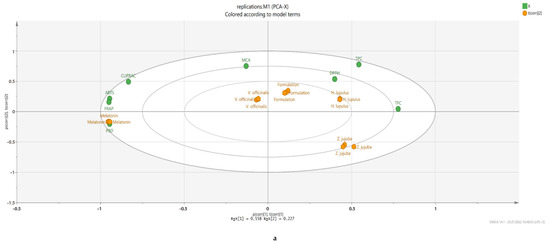
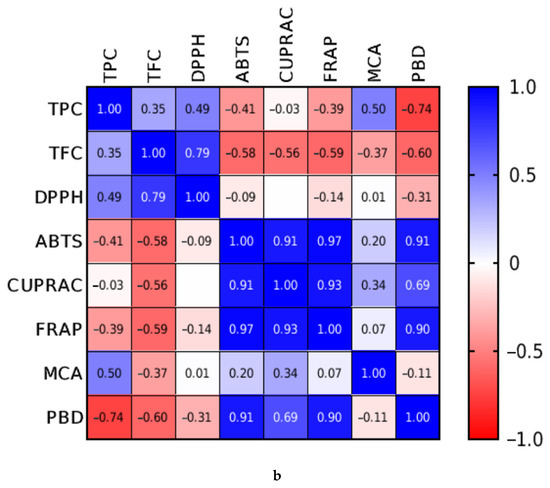
Figure 6.
Biplot presentation from principal component analysis between the tested samples (a), Pearson correlation values between biological activity assays (p < 0.05) (b).
4. Discussion
The hypothalamus has been recognized as playing a pivotal role in regulating the balance between sleep and arousal behavior, with different neuronal populations and neuromodulators being involved [30]. In this context, it is worth mentioning the arousal-inducing effects played by monoamines, namely norepinephrine and serotonin, and by orexins, neuropeptides, which are specifically synthesized in the hypothalamus [30]. Indeed, the administration of orexins and drugs stimulating the release of monoamines are effective to promote wakefulness [31,32]. By contrast, antagonists of orexinergic and monoaminergic pathways have been found to induce sleeping behavior [6,33].
The same mediators have been also related to the regulation of feeding [4,34], and neuroendocrine interactions, especially between serotonin and orexins, were described in the hypothalamus [35]. Additionally, serotonin and orexins could also play pivotal roles in migraines, and the association between insomnia and migraine has long been described by clinicians [36].
Due to the elevated prevalence of both migraine and insomnia as neurological diseases [36] and the side effects often associated to the use of first-line drugs [37], the search for new treatment options based on herbal preparations is increasing throughout the world [6,38,39].
Therefore, the present study investigated the potential of different herbal extracts from V. officinalis, Z. jujuba, and H. lupulus in the hypothalamus. Additionally, the study also considered the use of melatonin, a key regulator of sleep–wakefulness balance and a potent antioxidant [40]. Melatonin has been described not only in mammal cells but also in different plants, such as T. parthenium [15,17], an herbal remedy with phytotherapy use in migraine, which has the capability to restore monoaminergic signaling in the cortex and hypothalamus and to contrast the burden of inflammation and oxidative stress which are typical of neurological disorders [7,8,41,42].
Our results showed the intrinsic scavenging/reducing effects of the extracts, melatonin, and their pharmacological association. Regarding the herbal extracts, their antioxidant effects can be related, albeit partially, to the content of total phenols and flavonoids [16]. Intriguingly, H. lupulus displayed the highest content in total flavonoids and antiradical effects, compared with V. officinalis and Z. jujuba. Whilst the whole formulation displayed intermediate effects with respect to the single ingredients.
The intrinsic antioxidant effects also mirror the efficacy of the extracts and melatonin as protective agents, in the hypothalamus; indeed, the blunting effects on LPS-induced PGE2 and LDH demonstrate not the capability to prevent oxidative and inflammatory damage [43] but also confirm the biocompatibility of the single treatments and the formulation. Actually, these effects could be related, albeit partially, to the content of phenolic compounds present in the extracts and the intrinsic antioxidant effects of melatonin [16,40,44,45]. The scavenging/reducing effects of such substances are relevant in a neurological disorder such as insomnia, which is characterized by increased lipid peroxidation and reduced antioxidant defense systems [46].
Additionally, the extracts and melatonin were effective in reducing orexin A gene expression and serotonin steady state level in the hypothalamus. Intriguingly, the formulation was more effective than melatonin in reducing the activity of such hypothalamic neuromodulators. Currently, the present study did not permit proposing a mechanism of action underlying the observed effects. However, a previous study demonstrated the efficacy of a mixture, including V. officinalis and H. lupulus, in inducing sleeping behavior in Drosophila melanogaster [47], thus further strengthening the importance of the pharmacological association of herbal extracts for improving efficacy. Intriguingly, the same study proposed the modulation of GABA and serotonin pathways as potential targets of V. officinalis and H. lupulus. However, in the present study, V. officinalis extract and melatonin were ineffective in modifying hypothalamic serotonin level; thus, indicating H. lupulus and Z. jujuba as mainly responsible for the reduction of serotonin steady state concentration. The discrepancies between the results of Choi et al. [47] and our findings could be related, albeit partially, to the different preparation of the extracts. Indeed Choi et al. [47] used ethanol 70% as a solvent, and this can increase the solubility of low water soluble compounds, namely V. officinalis terpenes and H. lupulus phloroglucinol derivatives. By contrast, the water extracts from the same plant materials, as in the present study, may favor the solubility of phenolic compounds. In this context, it is noteworthy that the ability of valerenic acid to reduce serotonin turnover occurs at dosages much higher than its content in the employed extract (0.8%) [48]. This may influence our findings of null effect induced by V. officinalis extract on serotonin steady state level in the hypothalamus. However, we cannot exclude that the presence of phloroglucinol compounds in the H. lupulus extract may play a pivotal role in the increased serotonin level after exposing hypothalamic tissue to the hop extract.
It is also sensitive to highlight that in silico predictions proposed putative interactions between Z. jujuba and serotonin [49], although the authors of the study focused their attention on feeding, which is also finely regulated in the hypothalamus [35]. All tested extracts and melatonin were effective in reducing orexin A gene expression. There is still a lack in the scientific literature as regards direct interactions between the V. officinalis, H. lupulus, Z. jujuba, and orexins. Therefore, we hypothesize that, in the case of H. lupulus and Z. jujuba, the reduction of orexin A gene expression could be related, albeit partially, to the modulatory effect on serotonin, which has been found to interact directly with orexins [50]. By contrast the inhibition of orexin A gene expression induced by melatonin is consistent with its inhibitory effect on orexin neurons [35,51].
5. Conclusions
In conclusion, the present study explored the biological effects of melatonin and herbal extracts with phytotherapy interest from V. officinalis, Z. jujuba, and H. lupulus. The study demonstrated their intrinsic scavenging/reducing activity, together with protective, and neuromodulatory effects, in the hypothalamus, with a significant reduction of both orexin A gene expression and serotonin steady state level. Additionally, the study also considered their pharmacological association, which displayed an overall pharmacological spectrum mirroring and including all the effects played by the single ingredients, without showing any sign of toxicity in the brain and interference between the extracts and melatonin.
Therefore, the present study supports the rationale in combining the tested extracts with melatonin for counteracting insomnia. This would improve the efficacy compared with the single ingredients and with melatonin, this last representing the main natural compound used as a sleeping-inducer. However, further studies prove necessary for confirming the pharma-toxicological profiles, in terms of both efficacy and safety and also in terms of mechanisms of action, whose further investigation would be of relevance for ameliorating a rational and aware use.
Supplementary Materials
The following supporting information can be downloaded at: https://www.mdpi.com/article/10.3390/pr10081609/s1.
Author Contributions
Conceptualization, C.F. and L.M.; methodology, C.F. and L.M.; software, G.Z.; validation, C.F. and L.M.; formal analysis, C.F., G.Z., A.C., S.C.D.S. and L.M.; investigation, A.A., A.M., M.L.L., N., S.L., L.R., S.C.D.S. and A.C.; resources, L.M. and C.F.; data curation, A.C. and S.C.D.S.; writing—original draft preparation, C.F. and L.M.; writing—review and editing, C.F., L.M. and G.Z.; visualization, L.B. and G.O.; supervision, L.M. and C.F.; project administration, L.M. and C.F.; funding acquisition, L.M. and C.F. All authors have read and agreed to the published version of the manuscript.
Funding
The study was supported by Cristalfarma S.r.l. (Milano, Italy), which funded the industrial PhD project of Simonetta Cristina Di Simone. Tutors of the PhD project are Luigi Menghini and Claudio Ferrante.
Institutional Review Board Statement
Regarding the use of animals in scientific research: housing conditions and experimentation procedures were strictly in agreement with the European Community ethical regulations (EU Directive no. 26/2014) on the care of animals for scientific research. In agreement with the recognized principles of “Replacement, Refinement and Reduction in Animals in Research”, isolated hypotalami were obtained as residual material from vehicle-treated mice randomized in our previous experiments, approved by the local ethical committee (‘G. d’Annunzio’ University, Chieti, Italy) and the Italian Health Ministry (Project no. 885/2018-PR).
Data Availability Statement
Original data are available from the corresponding author upon reasonable request.
Acknowledgments
The study is also part of the third mission activity of the Botanic Garden “Giardino dei Semplici” of “G. d’Annunzio” University of Chieti-Pescara.
Conflicts of Interest
The authors declare no conflict of interest.
References
- Rosenwasser, A.M.; Turek, F.W. Neurobiology of Circadian Rhythm Regulation. Sleep Med. Clin. 2022, 17, 141–150. [Google Scholar] [CrossRef] [PubMed]
- Saidi, O.; Rochette, E.; Del Sordo, G.; Doré, É.; Merlin, É.; Walrand, S.; Duché, P. Eucaloric Balanced Diet Improved Objective Sleep in Adolescents with Obesity. Nutrients 2021, 13, 3550. [Google Scholar] [CrossRef] [PubMed]
- Jacobson, L.H.; Hoyer, D.; de Lecea, L. Hypocretins (orexins): The ultimate translational neuropeptides. J. Intern. Med. 2022, 291, 533–556. [Google Scholar] [CrossRef] [PubMed]
- Valassi, E.; Scacchi, M.; Cavagnini, F. Neuroendocrine control of food intake. Nutr. Metab. Cardiovasc. Dis. 2008, 18, 158–168. [Google Scholar] [CrossRef] [PubMed]
- Tabuchi, S.; Tsunematsu, T.; Kilduff, T.S.; Sugio, S.; Xu, M.; Tanaka, K.F.; Takahashi, S.; Tominaga, M.; Yamanaka, A. Influence of inhibitory serotonergic inputs to orexin/hypocretin neurons on the diurnal rhythm of sleep and wakefulness. Sleep 2013, 36, 1391–1404. [Google Scholar] [CrossRef]
- Feizi, F.; Namazi, N.; Rahimi, R.; Ayati, M.H. Medicinal Plants for Management of Insomnia: A Systematic Review of Animal and Human Studies. Galen Med. J. 2019, 8, e1085. [Google Scholar] [CrossRef]
- Di Giacomo, V.; Ferrante, C.; Ronci, M.; Cataldi, A.; Di Valerio, V.; Rapino, M.; Recinella, L.; Chiavaroli, A.; Leone, S.; Vladimir-Knežević, S.; et al. Multiple pharmacological and toxicological investigations on Tanacetum parthenium and Salix alba extracts: Focus on potential application as anti-migraine agents. Food Chem. Toxicol. 2019, 133, 110783. [Google Scholar] [CrossRef]
- Di Simone, S.C.; Acquaviva, A.; Libero, M.L.; Chiavaroli, A.; Recinella, L.; Leone, S.; Brunetti, L.; Politi, M.; Giannone, C.; Campana, C.; et al. The Association of Tanacetum parthenium and Salix alba Extracts Reduces Cortex Serotonin Turnover, in an Ex Vivo Experimental Model of Migraine. Processes 2022, 10, 280. [Google Scholar] [CrossRef]
- Ak, G.; Gevrenova, R.; Sinan, K.I.; Zengin, G.; Zheleva, D.; Mahomoodally, M.F.; Senkardes, I.; Brunetti, L.; Leone, S.; Di Simone, S.C.; et al. Tanacetum vulgare L. (Tansy) as an effective bioresource with promising pharmacological effects from natural arsenal. Food Chem. Toxicol. 2021, 153, 112268. [Google Scholar] [CrossRef]
- Yoon, J.-H.; Kim, E.H.; Park, S.B.; Lee, J.Y.; Yoon, S.W. Traditional Herbal Medicine for Insomnia in Patients with Cancer: A Systematic Review and Meta-Analysis. Front. Pharmacol. 2021, 12, 753140. [Google Scholar] [CrossRef]
- Min, B.; Ahn, Y.; Cho, H.-J.; Kwak, W.-K.; Suh, H.J.; Jo, K. GABAA Receptor-Mediated Sleep-Promoting Effect of Saaz–Saphir Hops Mixture Containing Xanthohumol and Humulone. Molecules 2021, 26, 7108. [Google Scholar] [CrossRef] [PubMed]
- Hua, Y.; Guo, S.; Xie, H.; Zhu, Y.; Yan, H.; Tao, W.-W.; Shang, E.-X.; Qian, D.-W.; Duan, J.-A. Ziziphus jujuba Mill. var. spinosa (Bunge) Hu ex H. F. Chou Seed Ameliorates Insomnia in Rats by Regulating Metabolomics and Intestinal Flora Composition. Front. Pharmacol. 2021, 12, 653767. [Google Scholar] [CrossRef] [PubMed]
- Ali, R.; Tariq, S.; Kareem, O.; Fayaz, F.; Aziz, T.; Meenu; Pottoo, F.H.; Siddiqui, N. Nutraceuticals for Sleep Disorders. Comb. Chem. High Throughput Screen. 2021, 24, 1583–1592. [Google Scholar] [CrossRef] [PubMed]
- Monti, J.M. Serotonin control of sleep-wake behavior. Sleep Med. Rev. 2011, 15, 269–281. [Google Scholar] [CrossRef]
- Arnao, M.B.; Hernández-Ruiz, J. The physiological function of melatonin in plants. Plant. Signal. Behav. 2006, 1, 89–95. [Google Scholar] [CrossRef]
- Ferrante, C.; Recinella, L.; Ronci, M.; Menghini, L.; Brunetti, L.; Chiavaroli, A.; Leone, S.; Di Iorio, L.; Carradori, S.; Tirillini, B.; et al. Multiple Pharmacognostic Characterization on Hemp Commercial Cultivars: Focus on Inflorescence Water Extract Activity. Food Chem. Toxicol. 2019, 125, 452–461. [Google Scholar] [CrossRef]
- Menghini, L.; Ferrante, C.; Leporini, L.; Recinella, L.; Chiavaroli, A.; Leone, S.; Pintore, G.; Vacca, M.; Orlando, G.; Brunetti, L. An Hydroalcoholic Chamomile Extract Modulates Inflammatory and Immune Response in HT29 Cells and Isolated Rat Colon. Phytother. Res. 2016, 30, 1513–1518. [Google Scholar] [CrossRef]
- Zengin, G.; Aktumsek, A. Investigation of antioxidant potentials of solvent extracts from different anatomical parts of Asphodeline anatolica E. Tuzlaci: An endemic plant to Turkey. Afr. J. Tradit. Complement. Altern. Med. 2014, 11, 481–488. [Google Scholar] [CrossRef]
- Uysal, S.; Zengin, G.; Locatelli, M.; Bahadori, M.B.; Mocan, A.; Bellagamba, G.; De Luca, E.; Mollica, A.; Aktumsek, A. Cytotoxic and Enzyme Inhibitory Potential of Two Potentilla species (P. speciosa L. and P. reptans Willd.) and Their Chemical Composition. Front. Pharmacol. 2017, 8, 290. [Google Scholar] [CrossRef]
- Di Giacomo, V.; Chiavaroli, A.; Orlando, G.; Cataldi, A.; Rapino, M.; di Valerio, V.; Leone, S.; Brunetti, L.; Menghini, L.; Recinella, L.; et al. Neuroprotective and neuromodulatory effects induced by cannabidiol and cannabigerol in rat hypo-E22 cells and isolated hypothalamus. Antioxidants 2020, 9, 71. [Google Scholar] [CrossRef]
- Orlando, G.; Leone, S.; Ferrante, C.; Chiavaroli, A.; Mollica, A.; Stefanucci, A.; Macedonio, G.; Dimmito, M.P.; Leporini, L.; Menghini, L.; et al. Effects of kisspeptin-10 on hypothalamic neuropeptides and neurotransmitters involved in appetite control. Molecules 2018, 23, 3071. [Google Scholar] [CrossRef] [PubMed]
- Livak, K.J.; Schmittgen, T.D. Analysis of relative gene expression data using real-time quantitative PCR and the 2(-Delta Delta C(T)) Method. Methods 2001, 25, 402–408. [Google Scholar] [CrossRef] [PubMed]
- Kara, M.; Öztaş, E.; Boran, T.; Karaman, E.F.; Veskoukis, A.S.; Tsatsakis, A.M. Ameliorative Effects of the Sesquiterpenoid Valerenic Acid on Oxidative Stress Induced in HepG2 Cells after Exposure to the Fungicide Benomyl. Antioxidants 2021, 10, 746. [Google Scholar] [CrossRef] [PubMed]
- Kowalska, G.; Bouchentouf, S.; Kowalski, R.; Wyrostek, J.; Pankiewicz, U.; Mazurek, A.; Sujka, M.; Włodarczyk-Stasiak, M. The hop cones (Humulus lupulus L.): Chemical composition, antioxidant properties and molecular docking simulations. J. Herb. Med. 2022, 33, 100566. [Google Scholar] [CrossRef]
- Lela, L.; Ponticelli, M.; Caddeo, C.; Vassallo, A.; Ostuni, A.; Sinisgalli, C.; Faraone, I.; Santoro, V.; De Tommasi, N.; Milella, L. Nanotechnological exploitation of the antioxidant potential of Humulus lupulus L. extract. Food Chem. 2022, 393, 133401. [Google Scholar] [CrossRef]
- Kırmızıbekmez, H.; Kúsz, N.; Bérdi, P.; Zupkó, I.; Hohmann, J. New iridoids from the roots of Valeriana dioscoridis Sm. Fitoterapia 2018, 130, 73–78. [Google Scholar] [CrossRef]
- Sudati, J.H.; Fachinetto, R.; Pereira, R.P.; Boligon, A.A.; Athayde, M.L.; Soares, F.A.; de Vargas Barbosa, N.B.; Rocha, J.B.T. In vitro antioxidant activity of Valeriana officinalis against different neurotoxic agents. Neurochem. Res. 2009, 34, 1372–1379. [Google Scholar] [CrossRef]
- Sen-Utsukarci, B.; Kessler, S.M.; Akbal-Dagistan, O.; Estep, A.S.; Tabanca, N.; Kurkcuoglu, M.; Demirci-Kayiran, S.; Eroglu-Ozkan, E.; Gul, Z.; Bardakci, H.; et al. Chemical composition and biological activities of Valeriana dioscoridis SM. roots. S. Afr. J. Bot. 2021, 141, 306–312. [Google Scholar] [CrossRef]
- Sánchez-Rangel, J.C.; Benavides, J.; Heredia, J.B.; Cisneros-Zevallos, L.; Jacobo-Velázquez, D.A. The Folin–Ciocalteu assay revisited: Improvement of its specificity for total phenolic content determination. Anal. Methods 2013, 5, 5990–5999. [Google Scholar] [CrossRef]
- Szymusiak, R.; McGinty, D. Hypothalamic regulation of sleep and arousal. Ann. N. Y. Acad. Sci. 2008, 1129, 275–286. [Google Scholar] [CrossRef]
- Dos Santos Moraes, W.A.; Burke, P.R.; Coutinho, P.L.; Guilleminault, C.; Bittencourt, A.G.; Tufik, S.; Poyares, D. Sedative antidepressants and insomnia. Braz. J. Psychiatry 2011, 33, 91–95. [Google Scholar] [CrossRef] [PubMed]
- Akanmu, M.A.; Honda, K. Selective stimulation of orexin receptor type 2 promotes wakefulness in freely behaving rats. Brain Res. 2005, 1048, 138–145. [Google Scholar] [CrossRef] [PubMed]
- Monti, J.M. The effect of second-generation antipsychotic drugs on sleep parameters in patients with unipolar or bipolar disorder. Sleep Med. 2016, 23, 89–96. [Google Scholar] [CrossRef] [PubMed]
- Kalra, S.P.; Dube, M.G.; Pu, S.; Xu, B.; Horvath, T.L.; Kalra, P.S. Interacting appetite-regulating pathways in the hypothalamic regulation of body weight. Endocr. Rev. 1999, 20, 68–100. [Google Scholar] [CrossRef]
- Brunetti, L.; Di Nisio, C.; Orlando, G.; Ferrante, C.; Vacca, M. The regulation of feeding: A cross talk between peripheral and central signalling. Int. J. Immunopathol. Pharmacol. 2005, 18, 201–212. [Google Scholar] [CrossRef]
- Waliszewska-Prosół, M.; Nowakowska-Kotas, M.; Chojdak-Łukasiewicz, J.; Budrewicz, S. Migraine and Sleep-An Unexplained Association? Int. J. Mol. Sci. 2021, 22, 5539. [Google Scholar] [CrossRef]
- Wider, B.; Pittler, M.H.; Ernst, E. Feverfew for preventing migraine. Cochrane Database Syst. Rev. 2015, 4, CD002286. [Google Scholar] [CrossRef]
- Sangermani, R.; Boncimino, A. The use of nutraceutics in children’s and adolescent’s headache. Neurol. Sci. 2017, 38, 121–124. [Google Scholar] [CrossRef]
- Lian, J.; Zhong, Y.; Li, H.; Yang, S.; Wang, J.; Li, X.; Zhou, X.; Chen, G. Effects of saffron supplementation on improving sleep quality: A meta-analysis of randomized controlled trials. Sleep Med. 2022, 92, 24–33. [Google Scholar] [CrossRef]
- Pandi-Perumal, S.R.; BaHammam, A.S.; Brown, G.M.; Spence, D.W.; Bharti, V.K.; Kaur, C.; Hardeland, R.; Cardinali, D.P. Melatonin antioxidative defense: Therapeutical implications for aging and neurodegenerative processes. Neurotox. Res. 2013, 23, 267–300. [Google Scholar] [CrossRef]
- Moscano, F.; Guiducci, M.; Maltoni, L.; Striano, P.; Ledda, M.G.; Zoroddu, F.; Raucci, U.; Villa, M.P.; Parisi, P. An observational study of fixed-dose Tanacetum parthenium nutraceutical preparation for prophylaxis of pediatric headache. Ital. J. Pediatr. 2019, 45, 36. [Google Scholar] [CrossRef] [PubMed]
- Recinella, L.; Chiavaroli, A.; Di Giacomo, V.; Antolini, M.D.; Acquaviva, A.; Leone, S.; Brunetti, L.; Menghini, L.; Ak, G.; Zengin, G.; et al. Anti-inflammatory and neuromodulatory effects induced by Tanacetum parthenium water extract: Results from in silico, in vitro and ex vivo studies. Molecules 2021, 26, 22. [Google Scholar] [CrossRef] [PubMed]
- Menghini, L.; Leporini, L.; Vecchiotti, G.; Locatelli, M.; Carradori, S.; Ferrante, C.; Zengin, G.; Recinella, L.; Chiavaroli, A.; Leone, S.; et al. Crocus sativus L. stigmas and byproducts: Qualitative fingerprint, antioxidant potentials and enzyme inhibitory activities. Food Res. Int. 2018, 109, 91–98. [Google Scholar] [CrossRef] [PubMed]
- Angelini, P.; Flores, G.A.; Piccirilli, A.; Venanzoni, R.; Acquaviva, A.; Di Simone, S.C.; Libero, M.L.; Tirillini, B.; Zengin, G.; Chiavaroli, A.; et al. Polyphenolic composition and antimicrobial activity of extracts obtained from grape processing by-products: Between green biotechnology and nutraceutical. Process. Biochem. 2022, 118, 84–91. [Google Scholar] [CrossRef]
- Ferrante, C.; Chiavaroli, A.; Angelini, P.; Venanzoni, R.; Flores, G.A.; Brunetti, L.; Petrucci, M.; Politi, M.; Menghini, L.; Leone, S.; et al. Phenolic content and antimicrobial and anti-inflammatory effects of solidago virga-aurea, phyllanthus niruri, epilobium angustifolium, peumus boldus, and ononis spinosa extracts. Antibiotics 2020, 9, 783. [Google Scholar] [CrossRef] [PubMed]
- Gulec, M.; Ozkol, H.; Selvi, Y.; Tuluce, Y.; Aydin, A.; Besiroglu, L.; Ozdemir, P.G. Oxidative stress in patients with primary insomnia. Prog. Neuropsychopharmacol. Biol. Psychiatry 2012, 37, 247–251. [Google Scholar] [CrossRef]
- Choi, H.-S.; Ko, B.S.; Kim, H.D.; Hong, K.-B.; Suh, H.J. Effect of Valerian/Hop Mixture on Sleep-Related Behaviors in Drosophila melanogaster. Biol. Pharm. Bull. 2017, 40, 1101–1110. [Google Scholar] [CrossRef]
- Jung, H.Y.; Yoo, D.Y.; Nam, S.M.; Kim, J.W.; Choi, J.H.; Yoo, M.; Lee, S.; Yoon, Y.S.; Hwang, I.K. Valerenic Acid Protects against Physical and Psychological Stress by Reducing the Turnover of Serotonin and Norepinephrine in Mouse Hippocampus-Amygdala Region. J. Med. Food 2015, 18, 1333–1339. [Google Scholar] [CrossRef]
- Zhu, Y.; Huang, J.; Shen, T.; Yue, R. Mechanism of Jujube (Ziziphus jujuba Mill.) Fruit in the Appetite Regulation Based on Network Pharmacology and Molecular Docking Method. Contrast Media Mol. Imaging 2022, 2022, 5070086. [Google Scholar] [CrossRef]
- Orlando, G.; Brunetti, L.; Di Nisio, C.; Michelotto, B.; Recinella, L.; Ciabattoni, G.; Vacca, M. Effects of cocaine- and amphetamine-regulated transcript peptide, leptin and orexins on hypothalamic serotonin release. Eur. J. Pharmacol. 2001, 430, 269–272. [Google Scholar] [CrossRef]
- Sharma, R.; Sahota, P.; Thakkar, M.M. Melatonin promotes sleep in mice by inhibiting orexin neurons in the perifornical lateral hypothalamus. J. Pineal Res. 2018, 65, e12498. [Google Scholar] [CrossRef] [PubMed]
Publisher’s Note: MDPI stays neutral with regard to jurisdictional claims in published maps and institutional affiliations. |
© 2022 by the authors. Licensee MDPI, Basel, Switzerland. This article is an open access article distributed under the terms and conditions of the Creative Commons Attribution (CC BY) license (https://creativecommons.org/licenses/by/4.0/).